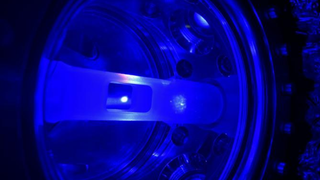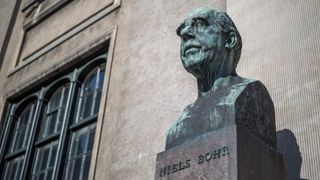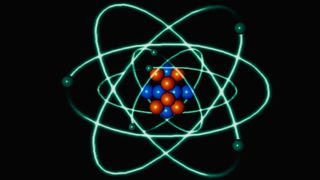Highly precise atomic clocks could soon get even better. Here's how
The theory was developed by Neils Bohr's great-grandson.

The use of a special type of atom could make even the most advanced atomic clocks more precise, scientists believe.
If confirmed, this breakthrough that could lead to more accurate GPS systems and better atomic clocks for use in space travel — it could even lead to devices that can detect earthquakes and volcanic eruptions with a higher level of accuracy. And fascinatingly, one of the researchers behind the development has a familiar name, based on a fitting family legacy rooted in the cutting edge of atomic science: Eliot Bohr. He's Neils Bohr's great-grandson.
Related: Atomic clocks on Earth could reveal secrets about dark matter across the universe
Of all the units humanity uses for measurement, the most precisely defined is the second, a fundamental unit of time. Crucial to this and all types of time measurements throughout history are different kinds of oscillations. Just as grandfather clocks use oscillations of a pendulum to measure time, atomic clocks define a second as 9,192,631,770 microwave oscillations of a cesium atom as it absorbs microwave radiation of a specific frequency.
Many modern atomic clocks use oscillations of strontium atoms rather than cesium to measure time; the most precise of these is accurate to within 1/15,000,000,000 of a second. This means that, even if it had been running since the dawn of time around 13.8 billion years ago, the clock still wouldn't have lost or gained a full second. Yet, for the majority of atomic clocks, which are used to keep Universal Coordinated Time (UTC) from positions around the globe and make sure our cell phones, computers and GPS tech is synchronized, there is still some room for improvement.
That's because the laser used to read the oscillations of atoms in atomic clocks heats up those atoms while doing so, causing them to escape the system. This can create some discrepancy, albeit incredibly slight. Still, researchers from the Niels Bohr Institute thinks they have found a way to eliminate the laser altogether, thus avoiding atomic heating and potential degradation of precision. It is an institute named for Eliot Bohr's great-grandfather, and one Bohr himself is affiliated with.
"We found that it is possible to read out the collective state of an atomic ensemble, as is required in atomic clocks and sensors, at an enhanced rate and with minimal heating using superradiance," lead researcher Eliot Bohr, who was a Ph.D. fellow at the institute, told Space.com. "There is a threshold for superradiance to occur for our chosen experimental geometry, and we can leverage this threshold in a clock sequence."
Get the Space.com Newsletter
Breaking space news, the latest updates on rocket launches, skywatching events and more!
Atomic clocks could be cooler
In current atomic clocks, 300 million or so hot strontium atoms are spat into a magneto-optical trap located within a vacuum chamber. This trap is a ball of atoms cooled to temperatures near absolute zero, the theoretical temperature at which all atomic movement would cease. Because of these temperatures, the introduced atoms lie almost still. This makes it possible for two mirrors with light between them to register their oscillations.
"In traditional atomic clocks, the detection heats up the atoms, requiring atoms to be freshly loaded," Bohr said. "This loading takes a while and causes downtime in the atomic clock cycle, limiting precision."
The team's sort of "paused" atoms that have been cooled so immensely, however, can be reused. This means they wouldn't need to be replaced as often, therefore leading to more precise atomic clocks.
Bohr explained that superradiant atoms are atoms that exist in a collective quantum state and are excited by the addition of energy in the form of photons, or particles of light. When the atoms release the photon-induced energy, or "decay," they all emit light in the same direction and at an enhanced rate.
"One cannot fundamentally distinguish which atom emitted which photon. They emitted them together, collectively," he added. "This enhanced emission rate allows for photons to be emitted much quicker from the type of atomic transitions that are used in atomic clocks."
This powerful light signal can be used to read out the atomic state of the collective strontium atoms, which means a laser isn't actually needed in the first place. And, again, because this process happens without the superradiant atoms being heated more than a very minimal amount, they won't need to be replaced.
Not only would doing away with the laser make more precise atomic clocks, but it could result in devices that are simpler and more portable.
"State-of-the-art atomic clocks are now so precise they are sensitive to gravity," Bohr said. "There are proposals that if we have atomic clocks that are portable and precise enough, we can place them strategically and better predict earthquakes and volcano eruptions by measuring certain variations in gravity."
Revolutionary atomic science is the family trade
Coming from a line of scientists who have been influential in our understanding of the subatomic world, Bohr may well have this sort of research in his blood. Most famous in this lineage is his great-grandfather, Niels Bohr, one of the fathers of quantum physics and a scientist who made a huge contribution to the understanding of the atomic structure, without which research like this couldn't happen.

In 1913, Niels Bohr, along with Ernest Rutherford, presented a model of the atom, suggesting it to be a dense nucleus surrounded by orbiting electrons. Though this "Bohr model" of the atom is now considered relatively simplistic compared to the detailed diagrams we have now, 111 years after its inception, it is still used to introduce students to the concept of the atom in classrooms across the globe.
Eliot Bohr's family's connection to the atomic structure goes deeper than this, too.
His grandfather is Aage Niels Bohr, who in 1975 was awarded the Nobel Prize in Physics along with Ben Roy Mottelson and James Rainwater for their discovery of the connection between collective motion and particle motion in atomic nuclei. This led to the development of an improved theory of the structure of the atomic nucleus.
"Both my great-grandfather and my grandfather inspired me greatly," Bohr said. "They both worked on theoretical work, understanding the atom and nucleus. My great-grandfather's theory that atoms can absorb a photon of a particular wavelength and go to an excited state, or emit a photon and decay to a lower state, is precisely what we do in our lab each and every day using lasers."

Bohr added that it is the open-mindedness demonstrated by his great-grandfather and colleagues that he finds particularly inspiring.
"The concepts are completely non-intuitive, but through rigorous data and debates, they accepted these new 'quantum' rules," Bohr said. "We now accept them and use them in many of our modern-day technologies. I hope to contribute to developing the next quantum technologies which will benefit society."
As for his superradient atomic clock research, Bohr said there are lots of possibilities for future advancements. The group he was part of in Copenhagen is now continuing to understand various properties of superradiant light to see how it can be harnessed for other situations.
Meanwhile, Bohr has started a postdoctoral research position at JILA, a joint institute between the National Institute of Standards and Technology (NIST) and the University of Colorado, Boulder. This is a lab that also studies superradiance and other collective atomic effects for next-generation quantum sensors.
"I plan to continue researching collective quantum effects which can be used in clocks and sensors," he concluded. "We have some ideas for further refining the method, such as finding the optimal parameters and understanding and reducing the noise level in the superradiant signal.
"There are a lot of possibilities to use superradiance to advance clocks and sensor technology."
The team's research was published in February in the journal Nature Communications.
Join our Space Forums to keep talking space on the latest missions, night sky and more! And if you have a news tip, correction or comment, let us know at: community@space.com.

Robert Lea is a science journalist in the U.K. whose articles have been published in Physics World, New Scientist, Astronomy Magazine, All About Space, Newsweek and ZME Science. He also writes about science communication for Elsevier and the European Journal of Physics. Rob holds a bachelor of science degree in physics and astronomy from the U.K.’s Open University. Follow him on Twitter @sciencef1rst.
-
Katakouzenos_1 Reply
I'm very very happy to hear that. Because they're using atomic energy for Destruction instead of Science and production. Who knows we could actually develop something like we see in science fiction. The mind is a miracle and a very organic computer if we put it to the right task. I really like this.Admin said:Superradiant atoms could help us measure time more precisely than ever before, a theory developed with the aid of the great-grandson of the "father of the atom," Niels Bohr.
Highly precise atomic clocks could soon get even better. Here's how : Read more -
Unclear Engineer It would be interesting to watch the evolution of the synchronous release of the photons from what I think they are describing as a Bose-Einstein condensate of atoms.Reply
MIT has now developed a camera system that can see a group of photons travel through matter, at a trillion frames per second. (See https://www.upworthy.com/mit-camera-speed-of-light-rp2 )
And there is also this: https://www.scientificamerican.com/article/see-the-highest-resolution-atomic-image-ever-captured/ .
So, maybe soon we will actually be able to "see" some of the things that quantum theory describes, and figure out how it really behaves. -
perilun We submitted a proposal for Blue Origin's Reef Starter Innovation Challenge (2022)Reply
Finalist: Enhanced Vibration Isolation - Endohedral Fullerenes Factory
Endohedral Fullerenes (specialized Buckyballs worth $100M/gram) may also be used in these in tiny atomic clocks (possibly in smart phones) and can be 10x as efficient to make in space.
